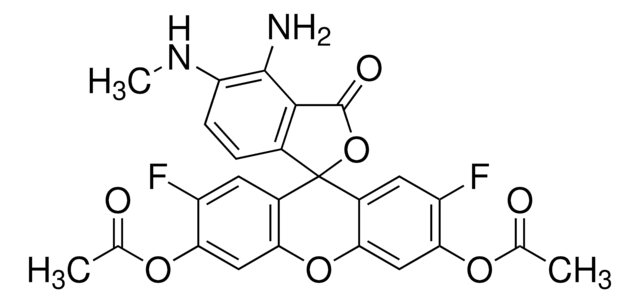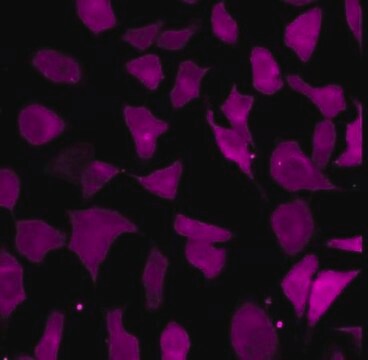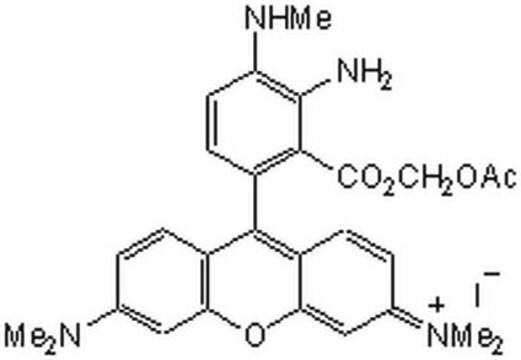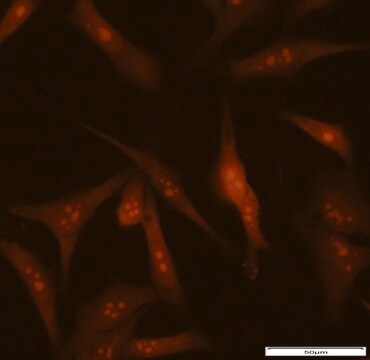SCT053
BioTracker SiRNO (Nitric Oxide)- Near Infrared Live Cell Dye
Live cell imaging dye for cellular nitric oxide (NO) localized to mitochondria and lysosome, used as an indicator of host defense, homeostasis and developmental functions.
Sinónimos:
Live cell imaging probe
Iniciar sesiónpara Ver la Fijación de precios por contrato y de la organización
About This Item
Código UNSPSC:
12352207
Productos recomendados
Análisis
≥98% (H-NMR)
≥98% (HPLC)
≥98% (LC/MS)
≥98% (elemental analysis)
técnicas
cell based assay: suitable
método de detección
fluorometric
Categorías relacionadas
Descripción general
Nitric oxide (No) is a reactive nitrogen species which is produced by nitric oxide synthase (NOS). NO is involved in many physiological processes including regulation of blood pressure, homeostasis, activation of immune system, neural communication, contraction of both smooth muscle and vascular tissue. Therefore, detection and quantification of NO is critical to understanding health and disease.
The BioTracker<TMSYMBOL></TMSYMBOL> SiRNO-Nitric oxide dye is a live cell near-infrared fluorescent imaging probe for detecting nitric oxide (NO). The probe targets NO specifically in the mitochondria and lysosome of living cells. The probe shows no cross reactivity to a variety of biomolecules and other reactive species including: ascorbic acid (AA), dehydroascorbic acid (DHA), methylglyoxal (MGO), GSH, Cys, Hcy, H2O2, ClO−, -OH, O2−, NO2−, and ONOO−. The SiRNO dye is pH insensitive in the range of 5.5 - 8.0, showing that it is suitable for physiological pH range. The SiRNO dye has been successfully used to detect NO in live cells, animal tissue and in vivo experiments.
Spectral Properties
Absorbance: 633nm
Emission: 650-750nm
The BioTracker<TMSYMBOL></TMSYMBOL> SiRNO-Nitric oxide dye is a live cell near-infrared fluorescent imaging probe for detecting nitric oxide (NO). The probe targets NO specifically in the mitochondria and lysosome of living cells. The probe shows no cross reactivity to a variety of biomolecules and other reactive species including: ascorbic acid (AA), dehydroascorbic acid (DHA), methylglyoxal (MGO), GSH, Cys, Hcy, H2O2, ClO−, -OH, O2−, NO2−, and ONOO−. The SiRNO dye is pH insensitive in the range of 5.5 - 8.0, showing that it is suitable for physiological pH range. The SiRNO dye has been successfully used to detect NO in live cells, animal tissue and in vivo experiments.
Spectral Properties
Absorbance: 633nm
Emission: 650-750nm
Aplicación
Live cell fluorescent imaging
Live cell imaging dye for cellular nitric oxide (NO) localized to mitochondria and lysosome, used as an indicator of host defense, homeostasis and developmental functions.
Research Category
Cell Imaging
Cell Imaging
Research Sub Category
Live Cell Dye
Live Cell Dye
Calidad
Purity: ≥ 98% confirmed by HNMR, LC-MS and HPLC and elemental analysis
Molar Mass: 758.34 g/mol
Molar Mass: 758.34 g/mol
Forma física
Lyophilized
Almacenamiento y estabilidad
Store BioTracker SiRNO-Nitric Oxide Live Cell Dye at -20°C, desiccate and protect from light
Note: Centrifuge vial briefly to collect contents at bottom of vial before opening.
Note: Centrifuge vial briefly to collect contents at bottom of vial before opening.
Cláusula de descargo de responsabilidad
Unless otherwise stated in our catalog or other company documentation accompanying the product(s), our products are intended for research use only and are not to be used for any other purpose, which includes but is not limited to, unauthorized commercial uses, in vitro diagnostic uses, ex vivo or in vivo therapeutic uses or any type of consumption or application to humans or animals.
Código de clase de almacenamiento
11 - Combustible Solids
Clase de riesgo para el agua (WGK)
WGK 3
Punto de inflamabilidad (°F)
Not applicable
Punto de inflamabilidad (°C)
Not applicable
Certificados de análisis (COA)
Busque Certificados de análisis (COA) introduciendo el número de lote del producto. Los números de lote se encuentran en la etiqueta del producto después de las palabras «Lot» o «Batch»
¿Ya tiene este producto?
Encuentre la documentación para los productos que ha comprado recientemente en la Biblioteca de documentos.
Zhiqiang Mao et al.
Analytical chemistry, 89(18), 9620-9624 (2017-08-29)
Two-photon (TP) fluorescent probes are potential candidates for near-infrared (NIR) imaging which holds great promise in biological research. However, currently, most TP probes emit at wavelength <600 nm, which impedes their practical applications. In this work, we explored the TP
Nuestro equipo de científicos tiene experiencia en todas las áreas de investigación: Ciencias de la vida, Ciencia de los materiales, Síntesis química, Cromatografía, Analítica y muchas otras.
Póngase en contacto con el Servicio técnico







